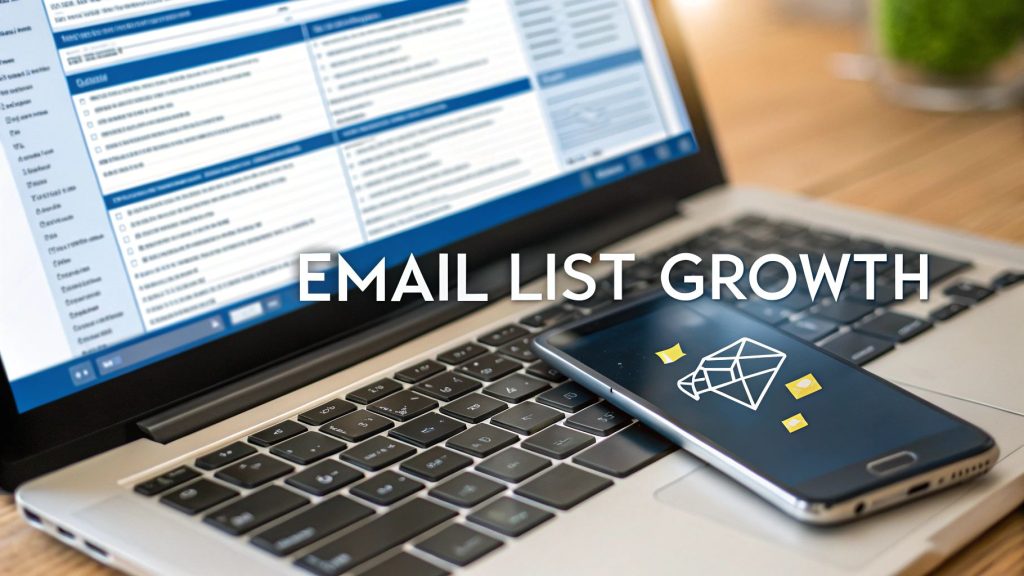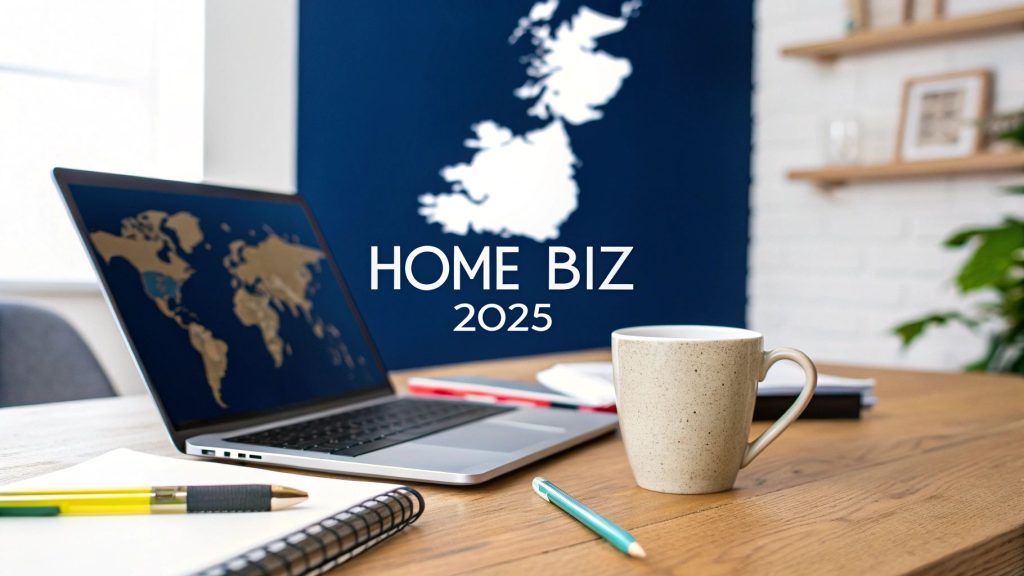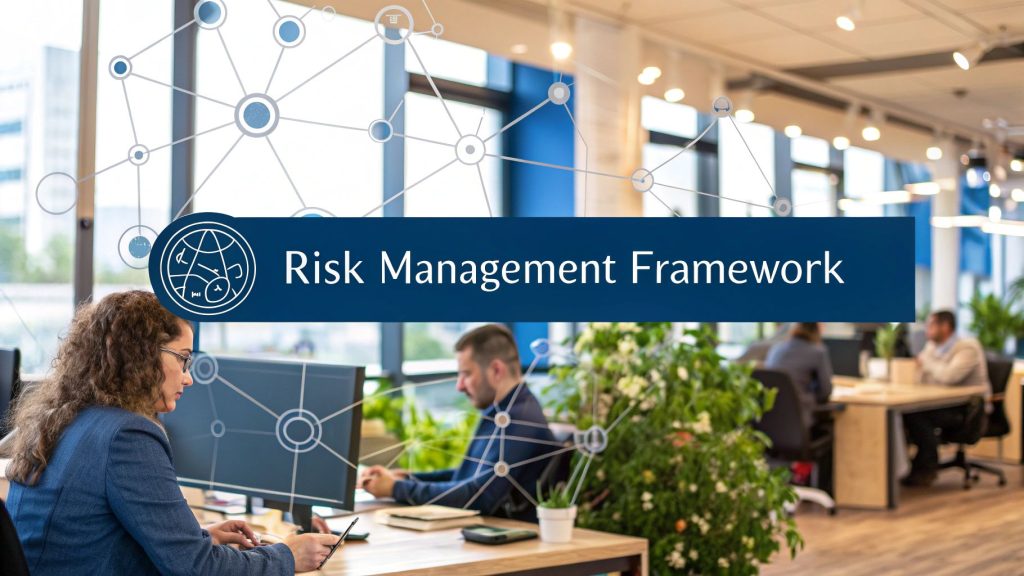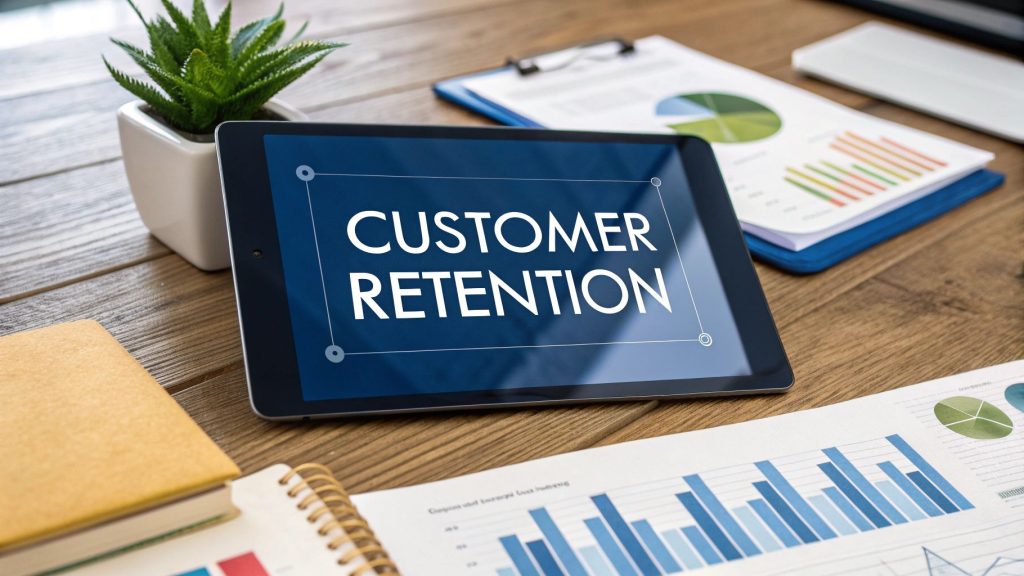How to Improve Customer Service
Improving customer service isn’t just about closing tickets faster. It’s about creating a seamless experience that weaves together genuine human connection with smart, efficient technology. The real goal is to deliver empathy, efficiency, and personalisation in every single interaction, making your customers feel valued and understood—not like another number in a queue. Get this right, and routine support becomes your most powerful loyalty-building tool.
What Excellent UK Customer Service Looks Like Today

The landscape of customer expectations here in the UK has shifted dramatically. Gone are the days when simply answering the phone was enough to keep people happy. Today’s consumers want more than a solution; they demand an experience that is quick, intelligent, and feels uniquely tailored to them.
This evolution is backed by the data. According to the latest UK Customer Satisfaction Index (UKCSI) report, overall satisfaction is climbing, hitting a score of 77.3 out of 100. This jump is strongly linked to businesses getting things right the first time and cutting down on the number of problems customers face in the first place. You can discover more about these UK satisfaction trends from The Institute of Customer Service.
This tells us something critical: excellence is no longer a bonus, it’s the baseline. Businesses that truly understand how to improve customer service are moving from a reactive to a proactive mindset. They anticipate needs, streamline their processes, and empower their teams to solve problems without getting tangled in red tape.
The Modern Service Framework
To really stand out, you need to build your service strategy on a few core pillars. These principles are the foundation of every positive customer interaction and are essential for any company wanting to make a real impact.
At the heart of it all are three simple, yet powerful, ideas. They guide everything from training your team to choosing the right software.
| Pillar | Description | Practical Example |
|---|---|---|
| Empathy & Human Connection | It’s about more than just solving a problem. It’s actively listening and understanding the customer’s emotional state, not just their technical issue. | An agent for a telco company hears a customer is moving house. After resolving their broadband query, they say, “Moving is so stressful. I hope the rest of your move goes smoothly!” |
| Seamless Efficiency | Customers value their time above almost anything else. An efficient experience means quick access to help, support on their preferred channels, and no unnecessary transfers. | A customer uses an app to report a missing food delivery item. Instead of a phone call, they get an instant, automated refund notification within 30 seconds. |
| Intelligent Personalisation | This goes way beyond using someone’s first name. It involves using data and past interactions to anticipate their needs and make them feel recognised. | A regular coffee shop customer who always orders an oat flat white is greeted with, “The usual oat flat white for you today?” by the barista. |
Ultimately, these pillars work together to create a service that feels effortless for the customer and builds trust for your brand.
The ultimate goal is to make the customer feel heard, helped, and valued. When you achieve this, you’re not just closing a ticket; you’re building a relationship that fosters long-term loyalty and turns customers into advocates for your brand.
A Tale of Two Retailers
Let’s look at a common scenario: a customer receives a damaged item from an online order.
Retailer A (Standard Service):
The customer has to find a generic contact form, then waits 48 hours for a reply. They’re asked to print a label, repackage the item, and trek to the post office. A replacement will only be sent once the damaged one is received. The process works, but it’s loaded with effort for the customer.
Retailer B (Excellent Service):
The customer uses a live chat option on the website. The agent immediately apologises, pulls up the order details, and arranges for a courier to collect the damaged item while simultaneously delivering a replacement the next day. The entire conversation takes five minutes.
Retailer B didn’t just solve the problem; they respected the customer’s time and turned a negative situation into a remarkably positive and memorable experience. This is the new standard.
Building Your Customer-Centric Team Culture

Exceptional customer service isn’t just a department—it’s a mindset that should run through every corner of your business. It all starts with building a company culture where every single employee, from the CEO down to the newest hire, is genuinely invested in the customer’s experience. This has nothing to do with scripts; it’s about creating an environment where people feel empowered to deliver greatness.
The very foundation of this culture is hiring the right people. While you can always teach technical skills, those innate qualities like empathy and a flair for creative problem-solving are much harder to instil. In fact, research shows that 86% of customers will ditch a brand after just one bad experience, making it absolutely vital to hire people who naturally want to help others.
Hiring for Empathy and Problem-Solving
When you’re looking to hire, you need to move beyond the standard CV and tired interview questions. Your focus should be on identifying candidates who demonstrate a natural talent for connection and resilience.
Here are a few practical examples of how to spot these qualities:
- Use Scenario-Based Questions: Instead of asking, “How would you handle an angry customer?”, give them a real, tricky scenario. Ask them to walk you through their thought process for helping a customer whose delivery is late and contains the wrong item.
- Look for Proactive Problem-Solvers: Ask about a time they spotted a problem before it blew up. For instance, “Tell me about a time you noticed a flaw in a process that was confusing for customers and what you did about it.”
- Assess Emotional Intelligence: Pay close attention to how they listen. Do they interrupt, or do they actually absorb what you’re saying before responding thoughtfully? You can even test this by giving them a slightly long-winded problem and seeing if they can summarise the key points back to you.
By putting these soft skills first, you build a team that’s naturally equipped to handle the human side of customer service, which is always the most challenging part.
Designing Training That Actually Works
Once you have the right people on board, your training programme needs to get them ready for real-world situations, not just textbook answers. Traditional, passive training often falls flat because it doesn’t prepare agents for the stress and nuance of a live interaction.
An effective training programme isn’t about memorising policies. It’s about building the confidence and autonomy to make smart decisions that benefit both the customer and the company.
Take a retail team, for example. They can be trained on so much more than just how to process a refund. A great training session would involve role-playing a tricky product complaint.
The Scenario: A customer returns a pair of walking boots because the sole started peeling after just two hikes. They’re clearly disappointed.
- Standard Training: The agent is taught to apologise and process the refund according to policy. Job done.
- Customer-Centric Training: The agent is trained to first empathise (“That’s incredibly frustrating, especially when you were relying on them for your hike.”). Then, after sorting the refund, they’re empowered to go a step further. They might say, “I know our new XT-model has a reinforced sole that our hiking community loves. As a thank you for your patience, here’s a 15% discount code if you’d like to give them a try.”
This simple shift turns a negative experience into a memorable, positive one. It doesn’t just fix the immediate problem; it reinforces the customer’s decision to shop with your brand. For more advanced strategies, our guide on dealing with difficult clients offers deeper insights into managing those challenging conversations.
Empowering Your Team with Autonomy
The final piece of the puzzle is trust. A customer-centric culture really thrives when employees have the autonomy to make decisions on the spot. Micromanaging every interaction or demanding manager approval for small gestures just creates bottlenecks and frustrates everyone involved.
When you empower your team, you’re sending a clear message: “We trust you to do the right thing for our customers.”
Here are some practical ways to empower your team:
- A “Surprise and Delight” Budget: A small discretionary fund they can use to send a little gift, offer a discount, or provide express shipping to a customer who’s had a rough time. A florist’s team might be allowed to add a complimentary box of chocolates to an order if they learn the delivery is for a bereavement.
- Freedom Within a Framework: Ditch the rigid scripts and provide guidelines instead. This allows agents to bring their own personality into conversations while still staying on-brand. For example, instead of a script, provide a checklist: “1. Greet warmly. 2. Acknowledge the problem. 3. Offer Solution X or Y. 4. Confirm satisfaction.”
- The Power to Make it Right: Give them the authority to resolve common issues—like offering a refund or a replacement for a faulty product—without needing to escalate.
This level of trust doesn’t just lead to faster resolutions and happier customers; it also boosts employee job satisfaction and reduces turnover. It really is the ultimate win-win.
Balancing Automation with a Human Touch
In the rush to embrace new technology, it’s easy to overlook your most powerful asset: the human element. For anyone wondering how to improve customer service, finding that sweet spot between the efficiency of automation and the warmth of a genuine human conversation is everything. Technology should be there to back up your team, not replace the empathy and understanding only a person can provide.
The trick is to use automation for what it does best – handling simple, repetitive tasks with speed and accuracy. This frees up your skilled agents to dive into the complex, high-stakes, or emotionally charged issues where they can truly make a difference.
A recent study gave us a clear picture of what UK consumers really want. While 54% said a timely response was their top priority, a very close 51% still prefer speaking directly to a human over a chatbot. This isn’t an “either/or” situation; it’s a clear signal that a hybrid approach is needed. It’s all about making tech and people work together seamlessly. You can explore more about UK customer preferences to see the full picture.
Knowing When to Automate and When to Escalate
The golden rule is pretty straightforward: automate the predictable, and humanise the exceptional. You need a clear strategy that maps out which customer queries are perfect for a chatbot and which need to be passed to a person straight away.
Here’s a practical way to think about it:
- Ideal for Automation:
- Order Status: “Where is my parcel?”
- Password Resets: “I can’t log in.”
- Basic FAQs: “What are your opening hours?”
- Appointment Booking: “Can I schedule a call?”
- Requires a Human Touch:
- Complex Technical Problems: When a customer has tried all the standard fixes and is getting nowhere.
- Billing Disputes: Money is a sensitive topic and often requires a proper investigation.
- Highly Emotional Situations: A customer who is upset, confused, or has a serious complaint.
- Pre-Sale Enquiries: A potential customer with detailed questions about whether your product is the right fit for them.
This infographic breaks down how chatbots and human agents stack up in key areas of customer service.
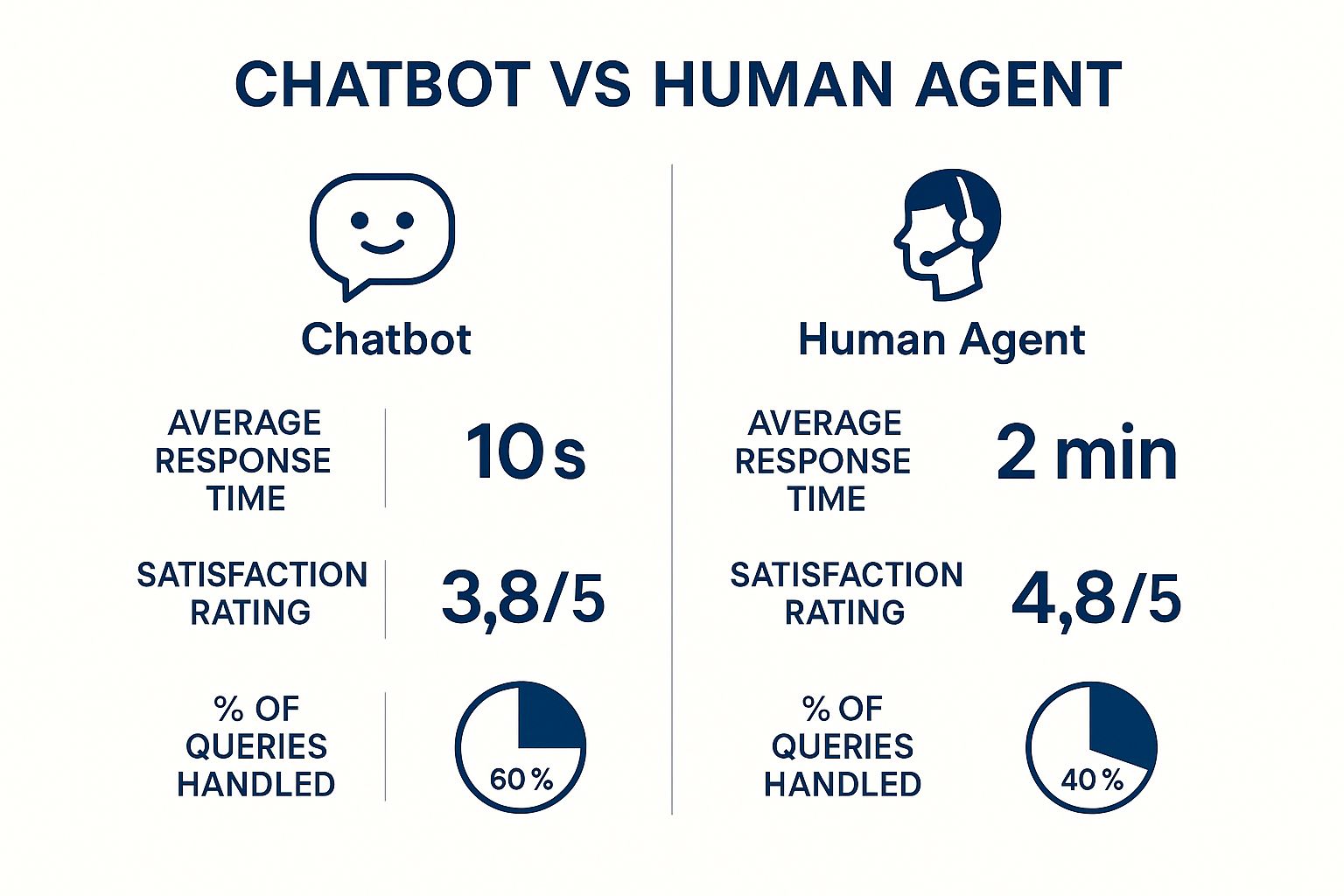
As the data shows, while chatbots win on speed, human agents deliver a much higher level of customer satisfaction. It just reinforces the need for both.
A Real-World Insurance Scenario
Let’s put this into practice. Imagine a customer needs to make a home insurance claim after something stressful like a burst pipe. A well-designed system can make this process far less painful.
An insurance company could use a chatbot for the initial information gathering. The bot can quickly ask for the policy number, the date of the incident, and what happened. This gets all the essential, straightforward details logged without making the customer wait in a queue.
But once that initial data is in, the system should offer a seamless transition to a human.
The bot could say, “Thank you for providing those details. I’m connecting you with one of our claims specialists now who can discuss the next steps with you and offer support.”
This handover is the most critical part. The human agent who takes over already has all the basic information, so they don’t need to make the customer repeat themselves. Instead, they can open the conversation with empathy, saying something like, “Hello, I’m sorry to hear about the burst pipe, that must be very stressful. I have your details here, let’s talk about how we can get this sorted for you.”
This approach respects the customer’s time with fast automation but delivers the reassuring human touch precisely when it’s needed most.
Boosting Empathy in Digital Channels
Active listening and empathy aren’t just for phone calls. These skills are vital across all your digital channels, from live chat to email. Here’s how you can train your team to project warmth and understanding through text:
- Use Reflective Language: Show you’re paying attention by acknowledging and rephrasing the customer’s issue. For example, “I understand you’re frustrated because the delivery hasn’t arrived on the expected date.”
- Validate Their Feelings: A few simple words can build an immediate connection and cool things down. Try phrases like, “I can see why that would be disappointing,” or “That sounds like a very difficult situation.”
- Avoid Robotic Phrases: Ditch the corporate jargon. Instead of “Your query has been escalated,” try something more human like, “I’ve passed this to our technical specialist, and they’ll get back to you within the hour.” It’s clearer and much warmer.
By mastering this balance, you create a service experience that is both efficient and genuinely caring—the true hallmark of excellent customer support.
Implementing a Seamless Omnichannel Strategy

Today’s customers don’t interact with your business in a straight line. They might spot an advert on social media, browse your website on their laptop, and later ask a question via live chat on their phone.
From their perspective, they’re not dealing with separate channels; they’re dealing with one brand. And they expect a single, connected conversation every time.
This is where a true omnichannel strategy becomes non-negotiable for anyone serious about improving customer service. It’s about much more than just being present on multiple platforms; it’s about making those platforms talk to each other so the customer never has to repeat themselves.
Omnichannel vs Multichannel Support: A Comparison
It’s easy to confuse these two terms, but the difference is huge from a customer’s point of view. Many businesses think they’re omnichannel when they’re actually just multichannel. This table breaks down the key distinctions:
| Feature | Multichannel Support | Omnichannel Support |
|---|---|---|
| Focus | Brand-centric: the brand is present on many channels. | Customer-centric: the customer’s experience is seamless across all channels. |
| Channel Integration | Channels operate in silos, unaware of each other. | Channels are fully integrated, sharing data and context. |
| Customer Experience | Fragmented. The customer has to repeat their issue on each channel. | Consistent. The conversation picks up where it left off, regardless of the channel. |
| Data & Context | Customer data is siloed within each channel. | A single customer profile tracks all interactions across every touchpoint. |
| Agent Perspective | Agents only see the interactions from their specific channel. | Agents get a 360-degree view of the entire customer journey. |
In short, multichannel is about being everywhere, while omnichannel is about being connected everywhere. It puts the customer at the absolute centre of your support strategy, ensuring context and conversation history follow them wherever they go.
Imagine this: a customer starts a query about a delivery on your website’s live chat during their lunch break. Later that day, they reply to a follow-up email from their phone. The next morning, they call to finalise the details. In a true omnichannel system, the agent who answers the phone instantly sees the entire history and can pick up the conversation exactly where it left off. No more, “Can you tell me what this is regarding?”
This is the seamless experience modern consumers now see as standard.
The Technology That Powers a Unified Experience
Making this magic happen relies on the right technology working behind the scenes. An integrated Customer Relationship Management (CRM) system is the foundation of it all. Think of it as a central hub, creating a single profile for each customer that logs every interaction, regardless of the channel.
When you pair this with a modern ticketing system, every email, chat transcript, social media message, and call note gets attached to that customer’s profile. This gives your support team a complete picture of the customer’s journey.
Key Tools for an Omnichannel Setup:
- Integrated CRM: A system like HubSpot or Salesforce that consolidates all customer data and interaction history in one place.
- Unified Ticketing System: Platforms such as Zendesk or Help Scout that pull communications from multiple channels into a single queue.
- Knowledge Base Integration: Tools that let agents quickly pull and share help articles within any channel, ensuring consistent answers.
Maintaining Consistency Across All Touchpoints
A unified tech stack is only half the battle. Your brand voice and quality of service have to remain consistent across every single channel. The friendly, informal tone your team uses on social media should match the helpfulness of your email support and the clarity of your phone agents. Our article on social media marketing for small business offers more guidance on crafting a consistent brand voice.
Consistency also means meeting expectations for speed. With online shopping making up over 27% of all retail sales in Great Britain, shoppers have high expectations. Research shows a staggering 67% of customers anticipate a response within two hours, whether it’s via WhatsApp, email, or a social media message.
This proves that a slow response on one channel can completely undermine a fast response on another, damaging the customer’s perception of your entire brand.
Switching to an omnichannel strategy is a significant move, but it’s one that directly addresses the reality of modern customer behaviour. It transforms your support from a series of disconnected conversations into a single, intelligent dialogue that builds genuine trust and loyalty.
Using Feedback and Data to Drive Improvement
Excellent customer service isn’t a destination you arrive at; it’s a continuous journey of listening, learning, and adapting. The only way to truly know if your efforts are paying off is to ask your customers and actually analyse the data they give you. A powerful feedback loop is the engine that drives constant, meaningful improvement.
This means moving beyond just hoping your customers are happy. It requires a deliberate strategy for collecting insights and, more importantly, a commitment to acting on what you discover. Without this, even the best-intentioned service initiatives are just guesswork.
Creating Your Customer Feedback Loop
The first step is to establish reliable channels for gathering what your customers are thinking. The goal is to make it incredibly easy for them to share their thoughts, whether they’re delighted or disappointed. A mix of methods almost always works best, capturing both broad sentiment and specific details.
Consider implementing a few of these proven feedback tools:
- Net Promoter Score (NPS): A simple survey asking, “On a scale of 0-10, how likely are you to recommend our business to a friend?” This gives you a high-level view of overall customer loyalty. A practical example is the automated email you get from a hotel a day after your stay asking you to rate them.
- Customer Satisfaction (CSAT): Typically sent after a specific interaction (like a support ticket resolution), this asks customers to rate their satisfaction with that single experience. Think of the simple “smiley face” or “star rating” you see at the end of a live chat session. It’s perfect for pinpointing immediate wins or failures.
- In-depth Interviews: For a deeper understanding, schedule brief calls with a handful of customers. This qualitative feedback provides the crucial “why” behind the numbers, revealing nuances you’d otherwise miss.
The key is consistency. Make feedback collection a regular, automated part of your customer journey so you have a steady stream of data to work with.
Great data doesn’t just tell you what happened; it tells you where to look next. Every support ticket, survey response, and customer review is a clue pointing towards an opportunity for improvement.
Turning Raw Data into Actionable Insights
Collecting feedback is only half the battle. The real value comes from turning that raw data into concrete actions that improve your service. This is where so many businesses falter, letting valuable insights gather digital dust in a spreadsheet somewhere.
The most effective approach is to look for patterns and recurring themes. Are multiple customers mentioning a confusing checkout process? Is a particular product generating a disproportionate number of support queries? These are your starting points.
A Practical SaaS Company Scenario:
Imagine a software-as-a-service (SaaS) company notices a recurring theme in its support tickets. Every week, at least 20% of queries are from new users struggling to set up a specific feature.
- The Data: Support agents are spending hours walking different customers through the exact same steps. The Customer Effort Score (CES) for these interactions is consistently low, showing just how frustrating customers find it.
- The Insight: The initial onboarding documentation for this feature is clearly inadequate. Customers can’t find the help they need on their own.
- The Action: Instead of just firefighting the tickets, the team creates a detailed, two-minute tutorial video demonstrating the setup process. They add this video to their help centre and link to it directly from the software’s dashboard.
The result? The following month, support tickets related to that feature drop by over 75%. This not only frees up agent time for more complex issues but also creates a far better first impression for new customers.
Key Metrics to Monitor for Continuous Growth
To systematically improve your customer service, you have to track the right numbers. These metrics give you an objective look at your team’s performance and shine a light on areas that need attention, like gaps in training or flaws in your processes.
Here are three essential metrics to keep on your dashboard:
- First Contact Resolution (FCR): What percentage of issues are solved during the very first interaction? A high FCR is a strong indicator of both agent expertise and efficient processes. For example, if 80 out of 100 customer calls are fully resolved without needing a follow-up, your FCR is 80%.
- Customer Effort Score (CES): How easy did you make it for the customer to get their problem solved? This is often a simple survey question like, “How easy was it to resolve your issue today?” on a scale of 1-5. This metric is a powerful predictor of loyalty.
- Average Handle Time (AHT): While speed isn’t everything, tracking how long it takes to resolve issues can help you identify agents who might need more training or processes that are creating bottlenecks. If one agent’s AHT is consistently twice the team average, it may signal a need for more support or training.
By regularly reviewing these metrics, you can spot problems before they escalate and make data-driven decisions that enhance both efficiency and customer satisfaction. This proactive approach is fundamental to building a service that not only meets but exceeds expectations, which is a core component of effective customer retention strategies.
Where Do You Go From Here?
Right, we’ve walked through the big strategies – everything from weaving a customer-first attitude into your company’s DNA to striking that perfect balance between slick automation and a genuine human touch. The ideas are on the table. Now comes the important part: turning them into reality.
If there’s one thing to take away from all this, it’s that learning how to get better at customer service isn’t just a nice-to-have. In a marketplace where everyone is shouting to be heard, it’s your most powerful and lasting competitive edge.
Real, sustainable excellence doesn’t come from a single magic bullet. It’s born from the interplay of three crucial elements: your people, the right technology, and sharp, data-driven insights. When these three work in harmony, you create an experience that’s not only efficient for your team but genuinely satisfying for your customers.
Think about it: an empowered agent, armed with a clear view of the customer’s history in a unified CRM, can tackle a complex problem with both speed and empathy. That’s how you turn a potential one-star review into a story of loyalty.
Just Take the First Step
It’s easy to look at the mountain of possibilities and feel a bit overwhelmed. That’s perfectly normal. The secret is to resist the urge to boil the ocean and try to fix everything at once. Instead, pick one thing and do it well.
The goal isn’t perfection overnight; it’s about making steady, consistent progress. One small, well-executed improvement is worth a hundred grand plans that never leave the drawing board.
So, here’s your immediate task:
- Scan back through this guide. Find one or two strategies that really speak to the challenges you’re facing right now.
- Commit to implementing just that one thing over the next 30 days. Maybe it’s as simple as launching your first Net Promoter Score (NPS) survey, or perhaps it’s running a single training session on active listening techniques.
This focused approach is how you build momentum. Every pound you put into improving your customer service is a direct investment in loyalty, retention, and the kind of healthy, long-term growth that every business dreams of.
Common Questions Answered
When you’re trying to level up your customer service, a few questions always seem to pop up. Here are some of the most common ones we hear, along with some straight-talking advice for UK businesses ready to make a change.
What’s the Single Most Important Thing for Better Customer Service in the UK?
It’s tempting to look for a silver bullet, but the truth lies in getting two things right: speed and the human touch. It’s a balancing act that UK customers now expect as standard.
Recent figures show that while over half of us want our queries sorted out fast, a similar number still want the option to speak to an actual person. The biggest win, then, is using tech to nail the simple, quick-fire questions while making sure it’s dead simple for customers to reach a well-trained, empathetic human when things get complicated. Getting one right without the other just doesn’t cut it anymore.
How Can a Small Business Improve Customer Service on a Tight Budget?
This is where small businesses can really shine. You don’t need a massive budget to make a huge difference; you just need to focus on the basics that bigger companies often forget. It’s about building genuine relationships, and that rarely costs a thing.
A few ideas that pack a punch without hitting your wallet:
- Set up a simple feedback loop. Even a one-question survey in a follow-up email shows you’re listening. A local bakery could include a QR code on their bags linking to a two-question Google Form about their experience.
- Trust your team. Give them the power to sort common problems on the spot. Nothing frustrates a customer more than being told, “I have to ask my manager.” For example, a café employee should be able to offer a free coffee if a customer’s order was made incorrectly, without needing approval.
- Make it personal. Using a customer’s name and remembering a past conversation shows you see them as a person, not a ticket number.
The real superpower of a small business is its ability to be nimble and personal. You don’t need a huge budget to make a customer feel valued and heard.
How Do I Actually Measure the ROI of Good Customer Service?
Measuring the return on your customer service efforts comes down to tracking a few key numbers that are directly tied to customer happiness. When you combine them, you start to see a clear financial picture.
First, look at your customer retention rate and Customer Lifetime Value (CLV). It’s simple: happy customers stick around longer and spend more money over time. Pair this with feedback scores like Net Promoter Score (NPS) or Customer Satisfaction (CSAT) and watch how they line up with your sales figures.
Don’t forget the operational savings, either. A drop in the number of support tickets or a jump in your First Contact Resolution rate means your team is spending less time and money fixing problems. That’s a direct saving that feeds straight into your ROI.
At Grow My Acorn, we provide the essential information and advice to help your business thrive. For more insights on building a successful enterprise, explore our resources at https://growmyacorn.co.uk.


